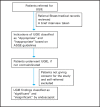Appropriateness of Indications of Upper Gastrointestinal Endoscopy and its Association With Positive Finding
- PMID: 30058633
- PMCID: PMC8997324
Appropriateness of Indications of Upper Gastrointestinal Endoscopy and its Association With Positive Finding
Abstract
Introduction: Upper Gastrointestinal Endoscopy is a frequently advised investigation for upper abdominal symptoms. Studies have questioned the appropriateness of indications for upper gastrointestinal endoscopy and have shown that inappropriate indications range from 5% to 49%. The unnecessary upper gastrointestinal endoscopy expose patients to the risk. The number of upper gastrointestinal endoscopy is rising in our region and we assume so is the number of unnecessary upper gastrointestinal endoscopy. With an aim to find out the appropriateness of the indications of upper gastrointestinal endoscopy and compare its association with positive findings, we conducted a cross-sectional descriptive study.
Methods: All patients undergoing diagnostic upper gastrointestinal endoscopy during study period were included in the study. Appropriateness of indications for upper gastrointestinal endoscopy was defined as per American Society for Gastrointestinal Endoscopy criteria as "appropriate" and "inappropriate". Upper gastrointestinal endoscopy findings were classified as "significant" and "insignificant" based on endoscopy findings. The extent of this association between appropriateness of indications and upper gastrointestinal endoscopy findings was expressed as the odds ratio of finding a relevant diagnosis in patients with an ''appropriate'' indication compared with those with an 'inappropriate'' indication.
Results: Seventy-nine patients were included in the study. Fifty- two (65.8%) of the indications were considered appropriate as per American Society for Gastrointestinal Endoscopy guidelines. Thirty-three (63.5%) of the appropriate indications has clinically significant finding as compared to seven (25.9%) of inappropriate indication with an odds ratio of 4.962 (95% CI:1.773 - 13.890, P=0.002) which is statistically significant.
Conclusions: Appropriate indications have significantly higher rates of clinically significant findings. Use of guidelines may decrease the number of unnecessary procedures.
Keywords: appropriateness; endoscopy; guidelines; indications..
Conflict of interest statement
None.
References
-
- Mahajan RJ, Barthel JS, Marshall JB. Appropriateness of referrals for open-access endoscopy. How do physicians in different medical specialties do? Arch Intern Med. 1996 Oct 14;156(18):2065–9. - PubMed
-
- Froehlich F, Burnand B, Pache I, Vader JP, Fried M, Schneider C, et al. Overuse of upper gastrointestinal endoscopy in a country with open-access endoscopy: a prospective study in primary care. Gastrointest Endosc. 1997 Jan;45(1):13–9. - PubMed
MeSH terms
LinkOut - more resources
Full Text Sources
Medical

